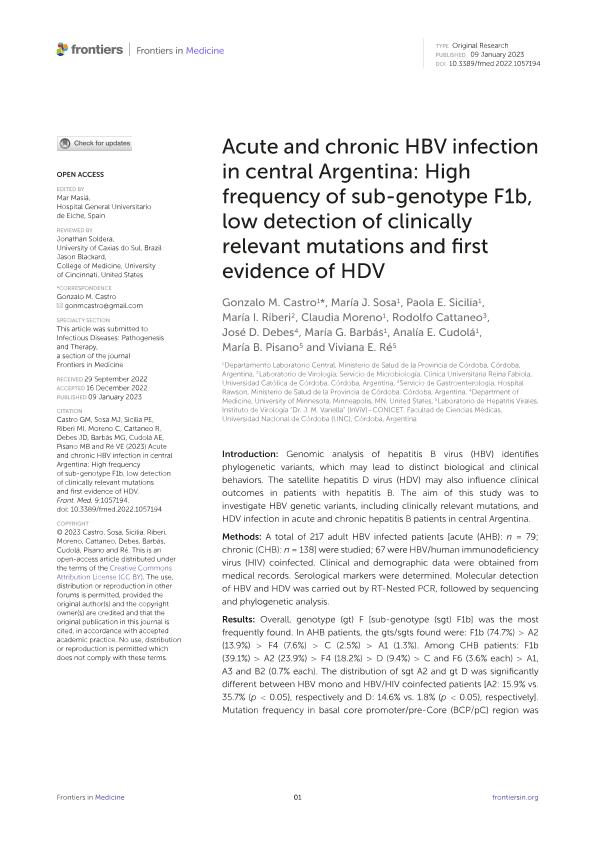Mostrar el registro sencillo del ítem
dc.contributor.author
Castro, Gonzalo Manuel

dc.contributor.author
Sosa, María J.
dc.contributor.author
Sicilia Don, Paola Ermelinda

dc.contributor.author
Riberi, María I.
dc.contributor.author
Moreno, Claudia
dc.contributor.author
Cattaneo, Rodolfo
dc.contributor.author
Debes, José D.
dc.contributor.author
Barbás, María G.
dc.contributor.author
Cudolá, Analía E.
dc.contributor.author
Pisano, María Belén

dc.contributor.author
Ré, Viviana Elizabeth

dc.date.available
2024-01-05T11:54:40Z
dc.date.issued
2023-01
dc.identifier.citation
Castro, Gonzalo Manuel; Sosa, María J.; Sicilia Don, Paola Ermelinda; Riberi, María I.; Moreno, Claudia; et al.; Acute and chronic HBV infection in central Argentina: High frequency of sub-genotype F1b, low detection of clinically relevant mutations and first evidence of HDV; Frontiers Media; Frontiers in Medicine; 9; 1-2023; 1-15
dc.identifier.uri
http://hdl.handle.net/11336/222513
dc.description.abstract
Introduction: Genomic analysis of hepatitis B virus (HBV) identifies phylogenetic variants, which may lead to distinct biological and clinical behaviors. The satellite hepatitis D virus (HDV) may also influence clinical outcomes in patients with hepatitis B. The aim of this study was to investigate HBV genetic variants, including clinically relevant mutations, and HDV infection in acute and chronic hepatitis B patients in central Argentina. Methods: A total of 217 adult HBV infected patients [acute (AHB): n = 79; chronic (CHB): n = 138] were studied; 67 were HBV/human immunodeficiency virus (HIV) coinfected. Clinical and demographic data were obtained from medical records. Serological markers were determined. Molecular detection of HBV and HDV was carried out by RT-Nested PCR, followed by sequencing and phylogenetic analysis. Results: Overall, genotype (gt) F [sub-genotype (sgt) F1b] was the most frequently found. In AHB patients, the gts/sgts found were: F1b (74.7%) > A2 (13.9%) > F4 (7.6%) > C (2.5%) > A1 (1.3%). Among CHB patients: F1b (39.1%) > A2 (23.9%) > F4 (18.2%) > D (9.4%) > C and F6 (3.6% each) > A1, A3 and B2 (0.7% each). The distribution of sgt A2 and gt D was significantly different between HBV mono and HBV/HIV coinfected patients [A2: 15.9% vs. 35.7% (p < 0.05), respectively and D: 14.6% vs. 1.8% (p < 0.05), respectively]. Mutation frequency in basal core promoter/pre-Core (BCP/pC) region was 35.5% (77/217) [AHB: 20.3% (16/79), CHB: 44.2% (61/138)]. In the open reading frame (ORF) S, mutations associated with vaccine escape and diagnostic failure were detected in 7.8% of the sequences (17/217) [AHB: 3.8% (3/79), CHB: 10.1% (14/138)]. ORF-P amino acid substitutions associated with antiviral resistance were detected in 3.2% of the samples (7/217) [AHB: 1.3% (1/79), CHB 4.3%, (6/138)]. The anti-HDV seropositivity was 5.2% (4/77); one sample could be sequenced, belonging to gt HDV-1 associated with sgt HBV-D3. Discussion: We detected an increase in the circulation of genotype F in Central Argentina, particularly among AHB patients, suggesting transmission advantages over the other genotypes. A low rate of mutations was detected, especially those with antiviral resistance implications, which is an encouraging result. The evidence of HDV circulation in our region, reported for the first time, alerts the health system for its search and diagnosis.
dc.format
application/pdf
dc.language.iso
eng
dc.publisher
Frontiers Media

dc.rights
info:eu-repo/semantics/openAccess
dc.rights.uri
https://creativecommons.org/licenses/by-nc-sa/2.5/ar/
dc.subject
ANTIVIRAL RESISTANCE
dc.subject
ARGENTINA
dc.subject
GENOTYPES
dc.subject
HBV
dc.subject
HEPATITIS B VIRUS
dc.subject
MUTANT
dc.subject.classification
Enfermedades Infecciosas

dc.subject.classification
Ciencias de la Salud

dc.subject.classification
CIENCIAS MÉDICAS Y DE LA SALUD

dc.title
Acute and chronic HBV infection in central Argentina: High frequency of sub-genotype F1b, low detection of clinically relevant mutations and first evidence of HDV
dc.type
info:eu-repo/semantics/article
dc.type
info:ar-repo/semantics/artículo
dc.type
info:eu-repo/semantics/publishedVersion
dc.date.updated
2024-01-03T12:33:37Z
dc.identifier.eissn
2296-858X
dc.journal.volume
9
dc.journal.pagination
1-15
dc.journal.pais
España

dc.description.fil
Fil: Castro, Gonzalo Manuel. Ministerio de Salud de la Provincia de Córdoba; Argentina. Consejo Nacional de Investigaciones Científicas y Técnicas; Argentina
dc.description.fil
Fil: Sosa, María J.. Ministerio de Salud de la Provincia de Córdoba; Argentina
dc.description.fil
Fil: Sicilia Don, Paola Ermelinda. Ministerio de Salud de la Provincia de Córdoba; Argentina
dc.description.fil
Fil: Riberi, María I.. Universidad Católica de Córdoba; Argentina
dc.description.fil
Fil: Moreno, Claudia. Ministerio de Salud de la Provincia de Córdoba; Argentina
dc.description.fil
Fil: Cattaneo, Rodolfo. Ministerio de Salud de la Provincia de Córdoba; Argentina
dc.description.fil
Fil: Debes, José D.. University of Minnesota; Estados Unidos
dc.description.fil
Fil: Barbás, María G.. Ministerio de Salud de la Provincia de Córdoba; Argentina
dc.description.fil
Fil: Cudolá, Analía E.. Ministerio de Salud de la Provincia de Córdoba; Argentina
dc.description.fil
Fil: Pisano, María Belén. Universidad Nacional de Córdoba. Facultad de Medicina; Argentina. Consejo Nacional de Investigaciones Científicas y Técnicas. Centro Científico Tecnológico Conicet - Córdoba; Argentina
dc.description.fil
Fil: Ré, Viviana Elizabeth. Universidad Nacional de Córdoba. Facultad de Medicina; Argentina. Consejo Nacional de Investigaciones Científicas y Técnicas. Centro Científico Tecnológico Conicet - Córdoba; Argentina
dc.journal.title
Frontiers in Medicine
dc.relation.alternativeid
info:eu-repo/semantics/altIdentifier/url/https://www.frontiersin.org/articles/10.3389/fmed.2022.1057194/full
dc.relation.alternativeid
info:eu-repo/semantics/altIdentifier/doi/https://doi.org/10.3389/fmed.2022.1057194
Archivos asociados
